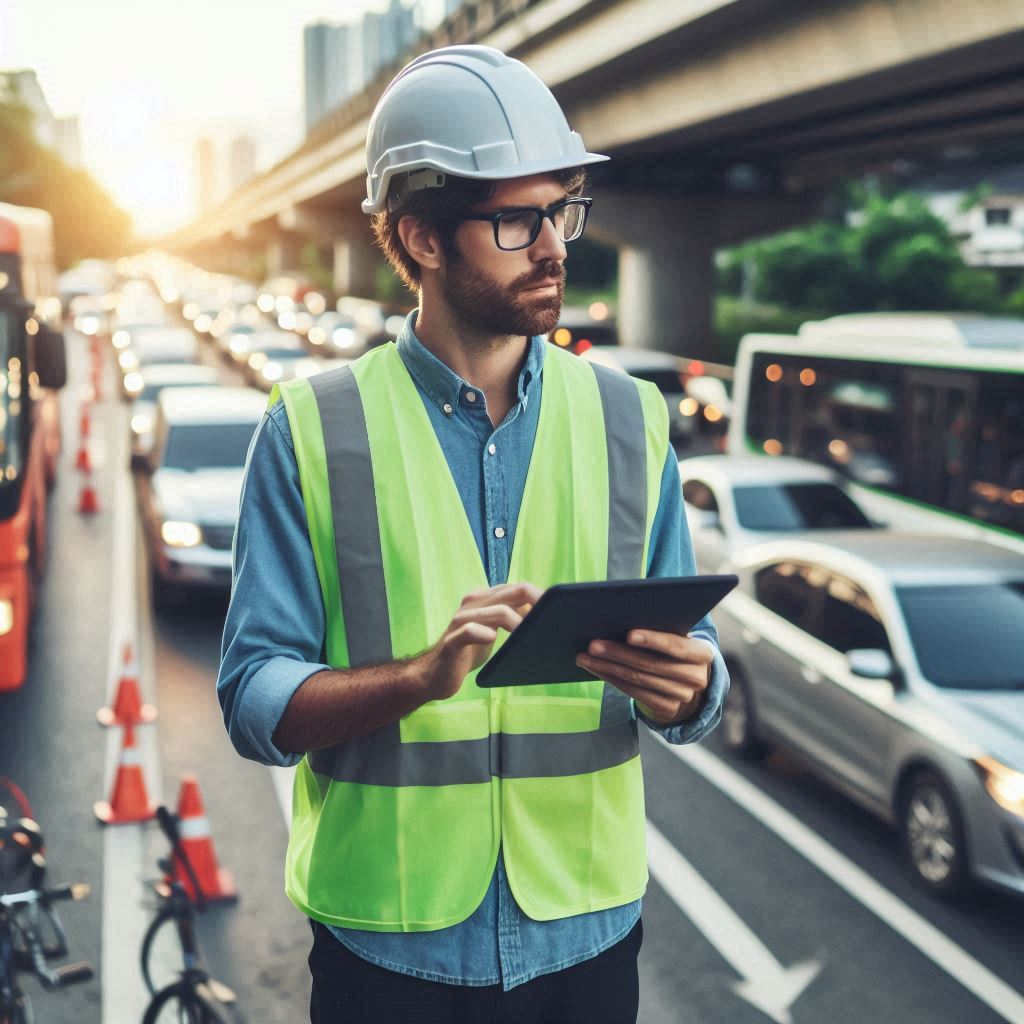Introduction
Efficient road design is crucial for modern transportation systems.
Well-designed roads reduce traffic congestion, minimize travel time, and enhance safety.
Transportation engineers play a vital role in this process.
They use their expertise to design roads that cater to increasing traffic demands and ensure smooth vehicle flow.
This section explores the key factors transportation engineers consider when designing efficient roads.
Brief Overview of the Importance of Efficient Road Design
Efficient road design significantly impacts a community’s economic and social well-being.
It ensures that people and goods can move swiftly and safely from one place to another.
Well-designed roads reduce travel time, save fuel, and lower vehicle maintenance costs.
Additionally, efficient road networks decrease traffic congestion, reducing pollution and improving air quality.
By facilitating quick and safe transportation, efficient roads support economic growth and enhance the quality of life for residents.
Mention of Transportation Engineers’ Role in Designing Roads
Transportation engineers are essential in creating efficient and safe road networks.
They analyze traffic patterns, study road usage, and predict future transportation needs.
Their expertise allows them to design roads that accommodate current and future traffic demands.
Engineers use advanced tools and technologies, such as computer-aided design (CAD) software and traffic simulation models, to create optimal road layouts.
They also consider environmental impact, ensuring their designs are sustainable and minimize ecological disruption.
Through meticulous planning and innovative solutions, transportation engineers ensure roads are safe, efficient, and resilient.
Thesis Statement Outlining the Key Factors That Transportation Engineers Consider in Designing Efficient Roads
Transportation engineers consider several key factors when designing efficient roads.
They analyze traffic flow, study road capacity, and consider safety measures.
They also evaluate environmental impact, plan for future expansion, and ensure cost-effectiveness.
By balancing these elements, engineers create road networks that enhance mobility, reduce congestion, and promote safety.
This section delves into these factors, highlighting the importance of each in designing roads that meet the needs of modern transportation systems.
Understanding Traffic Flow
Efficient road design starts with understanding traffic flow.
Transportation engineers analyze current traffic patterns and volumes, use traffic simulation software to predict future demands, and implement solutions to optimize flow and reduce congestion.
Analyzing Current Traffic Patterns and Volumes
Transportation engineers first analyze current traffic patterns and volumes.
They collect data through various methods such as traffic counts, sensor data, and video surveillance.
Engineers then examine peak travel times, identify bottlenecks, and determine areas with the highest traffic densities.
This analysis helps engineers understand the existing traffic dynamics and pinpoint areas that need improvement.
Accurate data collection and analysis are critical for making informed decisions in road design and planning.
Utilizing Traffic Simulation Software to Predict Future Traffic Demands
Predicting future traffic demands is essential for designing roads that can handle increased usage.
Transportation engineers utilize traffic simulation software for this purpose.
This software models traffic flow based on current data and various future scenarios.
By simulating different conditions, such as population growth and new developments, engineers can anticipate changes in traffic patterns.
This foresight allows them to design roads that accommodate future traffic volumes, ensuring long-term efficiency and minimizing the need for frequent upgrades.
Advanced simulation tools also help engineers test the effectiveness of proposed road designs before implementation.
Implementing Solutions to Optimize Traffic Flow and Reduce Congestion
After analyzing traffic data and predicting future demands, transportation engineers implement solutions to optimize traffic flow and reduce congestion.
They design roadways with features such as additional lanes, dedicated turn lanes, and roundabouts to improve traffic movement.
Engineers also incorporate intelligent transportation systems, such as adaptive traffic signals and real-time traffic monitoring, to manage traffic flow dynamically.
These systems adjust signal timings based on current traffic conditions, reducing wait times and preventing congestion.
Additionally, engineers may redesign intersections, add bypasses, or create new routes to distribute traffic more evenly across the network.
The goal is to enhance road capacity and ensure smooth and efficient traffic movement.
In review, transportation engineers play a crucial role in designing efficient roads by understanding traffic flow.
They analyze current traffic patterns and volumes, utilize traffic simulation software to predict future traffic demands, and implement solutions to optimize traffic flow and reduce congestion.
Through these efforts, engineers create roadways that meet current needs and anticipate future challenges, ensuring a safe and efficient transportation network.
Read: Biomedical Engineering: Regulatory Affairs
Consideration of road geometry
Designing curves, inclines, and grades to enhance safety and efficiency
Engineers carefully plan the alignment of roads, incorporating curves to ensure drivers can navigate them safely and efficiently.
By designing smooth curves, they prevent sharp turns that can lead to accidents and traffic congestion.
Inclines and grades are also important considerations, as steep slopes can be dangerous for vehicles, especially in adverse weather conditions.
Transportation engineers work to create gentle inclines and grades that are manageable for drivers, reducing the risk of accidents and improving overall efficiency.
Ensuring proper visibility for drivers at intersections and curves
At intersections and curves, visibility is crucial for drivers to anticipate traffic flow and make safe decisions.
Transportation engineers take into account factors such as line of sight, obstructions, and lighting to ensure optimal visibility on the road.
By designing roads with clear sightlines and well-lit areas, engineers enhance safety and efficiency, reducing the likelihood of accidents and traffic delays.
This strategic planning helps drivers navigate intersections and curves more effectively, improving the overall flow of traffic.
Incorporating proper lane width and shoulder space for different types of roads
Lane width and shoulder space are key considerations in road design, as they impact the safety and efficiency of traffic flow.
Transportation engineers tailor these elements to the specific needs of different types of roads, such as highways, urban streets, and rural routes.
By providing wider lanes on high-speed roads and narrow lanes on residential streets, engineers optimize traffic flow and enhance safety for drivers.
Additionally, incorporating sufficient shoulder space allows for emergency vehicles to access the road safely and provides a buffer zone for disabled vehicles, improving overall road efficiency.
Read: Graduate Studies in Biomedical Engineering
Selection of materials
Importance of material selection
Transportation engineers understand that selecting the right materials for road construction is crucial.
The materials used must be able to withstand the traffic volume and environmental conditions to ensure the longevity and safety of the road.
Traffic volume and climate conditions
One important consideration when choosing materials for road surfaces is the expected traffic volume.
High-traffic roads require durable materials that can withstand constant use without deteriorating quickly.
Additionally, climate conditions play a significant role in material selection.
Roads in areas with harsh weather conditions, such as extreme heat or cold, need materials that can withstand these challenges.
Sustainable materials
Transportation engineers are increasingly turning to sustainable materials for road construction to minimize the environmental impact.
These materials are often made from recycled or renewable sources, reducing the use of natural resources and lowering carbon emissions.
By incorporating sustainable materials into road design, engineers can help create more eco-friendly transportation infrastructure.
Regular maintenance
In addition to choosing the right materials, transportation engineers also emphasize the importance of regular maintenance to extend the lifespan of the road.
Routine inspections and repairs can identify issues early on, preventing larger problems and costly repairs down the line.
By maintaining the road surface properly, engineers can ensure its longevity and safety for motorists.
The selection of materials is a critical aspect of designing efficient roads.
By choosing appropriate materials based on traffic volume and climate conditions, utilizing sustainable materials, and conducting regular maintenance, transportation engineers can create roads that are safe, durable, and environmentally friendly.
Read: Networking Tips for Biomedical Engineers

Integration of Technology
Transportation engineers leverage technology to design efficient roads, enhancing traffic flow and safety.
By incorporating intelligent transportation systems, implementing smart lighting, and utilizing real-time traffic data, they ensure roads are adaptable and responsive to current demands.
Let’s explore how these technological advancements contribute to efficient road design.
Transform Your Career Today
Unlock a personalized career strategy that drives real results. Get tailored advice and a roadmap designed just for you.
Start NowIncorporating Intelligent Transportation Systems to Improve Traffic Signal Coordination
Engineers use intelligent transportation systems (ITS) to synchronize traffic signals, reducing congestion and improving travel times.
By analyzing traffic patterns, ITS adjusts signal timings dynamically, allowing smoother vehicle flow.
This coordination minimizes stop-and-go movements, decreasing fuel consumption and emissions.
Additionally, ITS helps prioritize emergency vehicles, enhancing response times.
Overall, integrating ITS into road design ensures more efficient and safer traffic signal operations.
Implementing Smart Lighting Systems for Enhanced Visibility and Safety
Smart lighting systems play a crucial role in improving road visibility and safety.
These systems use sensors to adjust lighting based on traffic volume, weather conditions, and time of day.
By providing optimal illumination, smart lighting reduces accidents and enhances driver confidence.
Furthermore, energy-efficient LED lights decrease maintenance costs and energy consumption.
The implementation of smart lighting systems ensures roads remain well-lit and safe, regardless of external conditions.
Utilizing Real-Time Traffic Data for Adaptive Traffic Management
Real-time traffic data is vital for adaptive traffic management, allowing engineers to respond swiftly to changing conditions.
By monitoring traffic flow, road incidents, and weather updates, engineers can implement immediate measures to mitigate congestion.
Adaptive traffic management systems reroute traffic, adjust speed limits, and provide real-time updates to drivers.
This data-driven approach enhances road efficiency and reduces travel time.
Utilizing real-time traffic data ensures roads are adaptable and resilient to varying traffic demands.
Incorporating these technological advancements into road design allows transportation engineers to create efficient, safe, and adaptive road systems.
By leveraging intelligent transportation systems, smart lighting, and real-time traffic data, engineers enhance traffic flow, reduce accidents, and respond effectively to changing conditions.
The integration of technology is essential for modern road design, ensuring roads meet the needs of today and the future.
Read: Biomedical Engineering: Impact on Public Health
Focus on Pedestrian and Cyclist Safety
Designing Sidewalks, Crosswalks, and Bike Lanes to Accommodate Non-Motorized Transportation
Transportation engineers prioritize non-motorized transportation by designing accessible sidewalks, crosswalks, and bike lanes.
Sidewalks need to be wide enough for pedestrians to walk comfortably and safely.
Engineers ensure these sidewalks have ramps for wheelchair access and smooth surfaces to prevent tripping.
Crosswalks are crucial for pedestrian safety, and engineers strategically place them at intersections and other high-traffic areas.
These crosswalks often feature bright markings and signals to alert drivers and protect pedestrians.
Bike lanes are another critical aspect of road design, providing cyclists with a dedicated space separate from motor vehicles.
Engineers design these lanes to be wide enough for safe cycling, often placing them between parked cars and traffic to minimize risks.
Implementing Traffic Calming Measures to Reduce Speed and Enhance Safety for Pedestrians and Cyclists
Traffic calming measures play a vital role in enhancing pedestrian and cyclist safety.
Engineers design roads to include features that naturally slow down traffic.
Speed bumps and humps are common tools used to reduce vehicle speed in residential and high-pedestrian areas.
Roundabouts and traffic circles also serve to control speed by requiring drivers to navigate these circular intersections carefully.
Narrower road lanes can effectively reduce vehicle speeds, making the environment safer for pedestrians and cyclists.
Additionally, curb extensions shorten the crossing distance for pedestrians, reducing their exposure to traffic.
Raised crosswalks and intersections further slow down vehicles, ensuring drivers are more aware of pedestrians and cyclists.
Engineers also use visual cues, such as pavement markings and colored bike lanes, to remind drivers of the presence of non-motorized road users.
Incorporating Pedestrian-Friendly Features Such as Benches and Lighting
Incorporating pedestrian-friendly features is essential for creating inviting and safe spaces.
Engineers add benches along sidewalks to offer rest spots for pedestrians, especially in areas with high foot traffic.
These benches provide convenience for elderly individuals, parents with young children, and others who may need a break.
Adequate lighting is crucial for pedestrian safety, particularly in the evening and nighttime.
Engineers ensure that streetlights are placed at regular intervals to illuminate sidewalks and crosswalks, deterring crime and reducing accidents.
Trees and landscaping can also enhance the pedestrian experience by providing shade and creating a pleasant environment.
Additionally, wayfinding signs help pedestrians navigate, indicating directions to key destinations.
Engineers design pedestrian zones with these features to promote walking as a viable and attractive mode of transportation.
In summary, transportation engineers prioritize pedestrian and cyclist safety through thoughtful design and strategic planning.
By creating accessible sidewalks, crosswalks, and bike lanes, implementing traffic calming measures, and incorporating pedestrian-friendly features, they ensure that roads are safe and efficient for all users.
These efforts not only enhance safety but also encourage more people to choose walking and cycling as sustainable transportation options.
You Might Also Like: How to Get Hired as a Biomedical Equipment Technician
Environmental Considerations in Road Design
Minimizing the Ecological Footprint of Road Construction and Maintenance
Transportation engineers strive to reduce the environmental impact of road construction and maintenance.
They use sustainable materials that are less harmful to the environment.
For example, recycled asphalt and concrete reduce waste and conserve resources.
Engineers also implement construction methods that minimize land disturbance and preserve natural habitats.
They plan routes to avoid sensitive areas and use techniques like soil stabilization to reduce erosion.
Maintenance practices also prioritize sustainability.
Using eco-friendly de-icing agents and reducing the frequency of resurfacing can lower the environmental impact.
Additionally, engineers design roads to require less frequent repairs, which further minimizes the ecological footprint.
Implementing Stormwater Management Practices to Reduce Runoff and Pollution
Effective stormwater management is crucial in road design.
Transportation engineers implement practices that reduce runoff and prevent pollution.
They design drainage systems that capture and filter stormwater before it enters natural water bodies.
Permeable pavements are another innovative solution.
These surfaces allow water to seep through, reducing runoff and recharging groundwater.
Engineers also incorporate green infrastructure, such as bioswales and rain gardens.
These features naturally filter pollutants and manage stormwater.
By controlling runoff, engineers help protect water quality and reduce the risk of flooding.
Additionally, they ensure compliance with environmental regulations and protect ecosystems from harmful pollutants.
Protecting Wildlife Habitats and Preserving Natural Landscapes During Road Development
Preserving wildlife habitats and natural landscapes is a key consideration in road development.
Transportation engineers conduct thorough environmental assessments to identify sensitive areas.
They design roads to avoid critical habitats and migration corridors.
When avoidance is not possible, they implement mitigation measures.
Wildlife crossings, such as overpasses and underpasses, allow animals to move safely across roads.
Engineers also use fencing to direct animals towards these crossings.
Landscaping and reforestation efforts help restore habitats and maintain natural aesthetics.
Additionally, engineers consider the impact of noise and light pollution on wildlife.
They implement measures to reduce these disturbances and protect biodiversity.
In a nutshell, transportation engineers play a vital role in designing environmentally responsible roads.
They minimize the ecological footprint of construction and maintenance, implement effective stormwater management practices, and protect wildlife habitats and natural landscapes.
These efforts ensure that road development aligns with sustainability goals and environmental regulations.
Through innovative design and careful planning, engineers contribute to a more sustainable and environmentally friendly transportation infrastructure.
Collaboration with Other Stakeholders
Effective road design relies heavily on collaboration with various stakeholders.
Transportation engineers must work closely with local government agencies, urban planners, and community members.
This cooperation ensures the development of efficient and safe roadways that meet the community’s needs.
Working Closely with Local Government Agencies, Urban Planners, and Community Members
Transportation engineers often collaborate with local government agencies, urban planners, and community members.
They attend meetings and workshops to gather input and share plans.
This collaboration helps align road designs with local development goals and zoning laws.
Engineers ensure that road projects support broader urban planning objectives, like reducing congestion and promoting sustainable transportation.
Engaging with community members provides engineers with valuable insights into local traffic patterns and problem areas.
By incorporating feedback, engineers design roads that enhance accessibility and safety for all users.
Considering Input from Residents and Businesses to Address Specific Needs and Concerns
Transportation engineers must consider input from residents and businesses to address specific needs and concerns.
They conduct surveys, public consultations, and community forums to gather opinions.
Residents and businesses often provide insights into traffic issues, safety concerns, and preferred design features.
Engineers use this information to refine road designs, ensuring they address local needs.
For instance, engineers might adjust road widths, add pedestrian crossings, or implement traffic calming measures based on community feedback.
This inclusive approach fosters community support and ensures road designs are practical and effective.
Collaborating with Utility Companies to Coordinate Infrastructure Improvements and Minimize Disruptions
Transportation engineers also collaborate with utility companies to coordinate infrastructure improvements and minimize disruptions.
Road construction often intersects with utility infrastructure, such as water, gas, and electrical lines.
Engineers work with utility companies to plan and schedule roadworks to minimize service interruptions.
This coordination helps ensure that road projects do not damage existing utilities or disrupt essential services.
Engineers also plan for future utility needs, incorporating infrastructure upgrades into road designs.
This proactive approach reduces the need for subsequent roadworks, minimizing long-term disruptions.
Effective collaboration with utility companies ensures smoother project execution and better integration of road and utility infrastructure.
See Related Content: Key Differences Between Wind Techs and Engineers
Explore Further: Essential Skills for Field Service Technicians
Conclusion
Efficient road design is crucial for promoting safety and sustainability in transportation systems.
It plays a significant role in ensuring smooth traffic flow, reducing congestion, and minimizing accidents.
Transportation engineers are essential in designing roads that cater to the needs of diverse users, including pedestrians, cyclists, and motorists.
Their expertise in applying innovative technologies and smart design principles is paramount for creating efficient road networks that enhance overall transportation efficiency.
As transportation challenges evolve, ongoing research and innovation in road design are imperative.
Engineers must stay abreast of new technologies, materials, and design approaches to address the changing needs of society.
This involves incorporating sustainable practices, adopting smart transportation systems, and implementing multi-modal solutions to optimize road performance.
By emphasizing the critical role of transportation engineers in designing efficient roads, we can create safer, more sustainable, and user-friendly transportation networks.
Collaboration between engineers, policymakers, and stakeholders is key to ensuring that road design meets the needs of all users while promoting safety, sustainability, and efficiency in transportation systems.
[E-Books for Sale]
The Big Book of 500 High-Paying Jobs in America: Unlock Your Earning Potential
$19.99 • 500 High-Paying Jobs • 330 pages
Explore 500 high-paying jobs in America and learn how to boost your career, earn more, and achieve success!
See All 500 High-Paying Jobs of this E-Book
1001 Professions Without a Degree: High-Paying American Jobs You Can Start Now
$19.99 • 1001 Professions Without a Degree • 174 pages
Discover 1001 high-paying jobs without a degree! Unlock career tips, skills, and success strategies for just $19.99!




